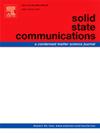Electronic property modulation of zigzag single-walled silicon nanotubes by carbon doping concentration
IF 2.1
4区 物理与天体物理
Q3 PHYSICS, CONDENSED MATTER
引用次数: 0
Abstract
The unique properties of silicon nanotubes endow them with broad application prospects in many fields, including biosensors, solar cells and optoelectronic devices. In this paper, the effects of the carbon doping concentration on the geometrical and electronic properties of two sizes of zigzag single-walled silicon nanotubes (ZSiNTs), denoted as ZSiNT (5,0) and ZSiNT (6,0), were investigated by the self-consistent charge density functional tight-binding (SCC-DFTB) method. The increment of the carbon doping concentration can generally improve the structural stability of all the nanotubes, which arises from the increase in the proportion of the short Si-Si bond and the binding energy. Certain patterns of carbon doping have been found to regulate the band gap with a significantly larger band gap opening range for ZSiNT (5,0) compared to ZSiNT (6,0). Energy band structures indicate that carbon-doped ZSiNTs exhibit three conductive types: direct band gap semiconductor, indirect band gap semiconductor, and semi-metals. In addition, the concentration of carbon doping significantly affects the amount of charge transfer, and the charge moves to the position of carbon atom doping.

碳掺杂浓度对之字形单壁硅纳米管电子性能的调制
硅纳米管的独特性质使其在生物传感器、太阳能电池、光电器件等领域具有广阔的应用前景。本文采用自一致电荷密度功能紧密结合(SCC-DFTB)方法研究了碳掺杂浓度对ZSiNT(5,0)和ZSiNT(6,0)两种尺寸之字形单壁硅纳米管(ZSiNT)几何和电子性能的影响。碳掺杂浓度的增加一般能提高所有纳米管的结构稳定性,这是由于硅硅短键的比例和结合能的增加。碳掺杂的某些模式可以调节带隙,与ZSiNT(6,0)相比,ZSiNT(5,0)的带隙开放范围明显更大。能带结构表明,碳掺杂ZSiNTs表现出三种导电类型:直接带隙半导体、间接带隙半导体和半金属。此外,碳掺杂浓度显著影响电荷转移量,电荷向碳原子掺杂位置移动。
本文章由计算机程序翻译,如有差异,请以英文原文为准。
求助全文
约1分钟内获得全文
求助全文
来源期刊

Solid State Communications
物理-物理:凝聚态物理
CiteScore
3.40
自引率
4.80%
发文量
287
审稿时长
51 days
期刊介绍:
Solid State Communications is an international medium for the publication of short communications and original research articles on significant developments in condensed matter science, giving scientists immediate access to important, recently completed work. The journal publishes original experimental and theoretical research on the physical and chemical properties of solids and other condensed systems and also on their preparation. The submission of manuscripts reporting research on the basic physics of materials science and devices, as well as of state-of-the-art microstructures and nanostructures, is encouraged.
A coherent quantitative treatment emphasizing new physics is expected rather than a simple accumulation of experimental data. Consistent with these aims, the short communications should be kept concise and short, usually not longer than six printed pages. The number of figures and tables should also be kept to a minimum. Solid State Communications now also welcomes original research articles without length restrictions.
The Fast-Track section of Solid State Communications is the venue for very rapid publication of short communications on significant developments in condensed matter science. The goal is to offer the broad condensed matter community quick and immediate access to publish recently completed papers in research areas that are rapidly evolving and in which there are developments with great potential impact.
 求助内容:
求助内容: 应助结果提醒方式:
应助结果提醒方式:


